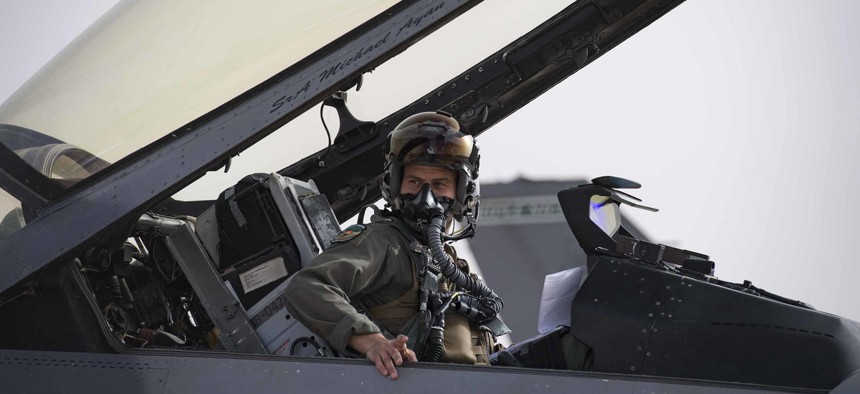The USAF’s Bad Bets on Pilot Retention Show It Needs Outside Help
Service leaders think the same old tactics can reverse a pilot shortage in a resurging economy.
Despite the pandemic, the Air Force is still short of pilots, thanks to low retention and strong airline hiring. Before COVID-19 reached the United States, the Air Force had a deficit of more than 2,000 pilots, requiring $15 billion to train replacements. The pandemic temporarily paused airline hiring to the Air Force’s relief, reducing pilot losses, but Covid-19 also hampered pilot training, leaving the overall shortage almost unchanged. Instead of using the reprieve as an opportunity to try bolder retention initiatives, the Air Force recently placed a large wager against airline recovery and renewed airline pilot hiring. Its bet against prevailing macroeconomic trends shows that the Air Force has a brewing personnel issue so severe that outside intervention is now required.
Before the pandemic, the Air Force offered retention contracts as short as three years to pilots completing their initial ten-year commitments. Seizing on the collapse of airline hiring in 2020, though, the service changed the terms of its contracts. Gone are three- and four-year contracts; the shortest pilot contract is now five years, which gets you about 70 percent of the maximum retention bonus. To get the full amount authorized by Congress—$35,000 per year—the Air Force requires at least an eight-year commitment. These are hardball terms compared to past years and are a strong bet that airline pilot hiring will be weak for an extended period.
Unfortunately, the Air Force doesn’t have the negotiating leverage it thinks it does, for three reasons.
First, thanks to the financial lifelines Congress extended, the economy and passenger airlines survived 2020 and are poised to make a big comeback this year. The Federal Reserve updated its GDP growth predictions in March and now expects the U.S. economy to grow between 5 percent and 7.3 percent in 2021. With U.S. COVID-19 vaccine deployment accelerating, Americans are flying again and in higher numbers than expected, leaving airlines scrambling to keep up with the demand.
Second, major passenger airlines will start hiring pilots again soon. Some, like Spirit and United Airlines, have already announced plans to do so. In fact, logistics airlines like UPS and FedEx maintained strong pilot hiring throughout the pandemic. Even if airline travel recovers slowly, the airlines face a big problem: mandatory retirements. According to the Federal Aviation Administration, there were 21,292 airline pilots within five years of the maximum age of 65 to fly passengers, an increase of 26 percent from five years earlier. This wave of impending retirements is why airlines retained every pilot they could during the pandemic.
Finally, Air Force pilots are poised to leave active duty, not stay, according to our research. Despite the incredibly dire economic and health conditions in 2020, only 51 percent of the Air Force’s eligible pilots signed retention contracts, a small increase from recent years. Of those pilots who signed retention contracts last year, though, we found that 33 percent signed on for only three years. The rest stayed on active duty without service commitments and are now free agents able to depart on short notice. Air Force pilots are keeping their options open and believe airline hiring will return soon, offering better opportunities.
Pilots continue to be dissatisfied with their families’ quality of life and the increased workload of non-flying duties. But instead of continuing to address its pilots’ concerns, the Air Force quietly abandoned retention in 2018 and shifted its focus to increasing pilot production. To be fair, the Air Force badly needs to address pilot production, too, as it didn’t train enough pilots during the last decade. However, retention is the Air Force’s key to cost-effective pilot manning, according to a 2019 RAND study. Experienced pilots are needed to train newer ones. Balancing retention and production make better use of Congressionally-appropriated taxpayer dollars.
The Air Force has erred in positioning itself opposite the improving economy, airline hiring, and the pandemic’s end. When Air Force pilots start heading for the exits again soon, the Department of Defense will have problems meeting its commitments. The upcoming Senate Armed Services Committee Posture Hearings are a perfect opportunity to discuss this readiness problem. Given the issue’s enduring nature, we suggest commissioning an outside panel of experts to take a hard look and make substantive recommendations to improve Air Force pilot retention.
The views expressed in this article are those of the authors. They do not reflect the official policy or position of the Air Force, the Department of Defense, or the U.S. Government.
Brian Kruchkow is a U.S. Air Force officer and instructor pilot at Laughlin Air Force Base, Texas.
Tobias Switzer is a U.S. Air Force officer and military fellow at the Center for Strategic and International Studies in Washington D.C., where he recently published a report on Air Force pilot retention.



